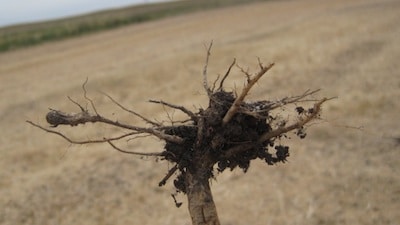
Provincial disease surveys are based primarily on pre-swathing counts. Full plants make it easier to accurately identify diseases, and to get severity ratings.
Growers may find it easier to check crops while swathing. Stop at five random spots in the field while swathing and check 20 standing plants at each spot. This will give you a good idea how much of the field actually had sclerotinia or blackleg or clubroot, for example. (See the following article for diseases to look for.)
Going out after swathing and checking stubble can also work to identify disease that has infecting stem bases or roots — which tend to have the biggest impact on yield. These could include blackleg basal infection, sclerotinia main stem infection and clubroot galls. You will want to go out within a few days of swathing, ideally, and no later than a week otherwise roots and stems will have started to decay and disease symptoms may not be as easy to identify. Immediately after swathing, bleached stems from blackleg or sclerotinia are fairly easy to spot. After a week, all canola stems start to have a bleached appearance.
After 3-4 days, the swathed crop is also still present, so stems from plants in the swath can also be counted and compared for disease incidence and severity.
Be random. Random sampling is important for an accurate overall assessment of disease, but stopping at known diseased patched while swathing is a good idea, too. This will give you a chance to identify the disease, which is an important first step in management for next year.